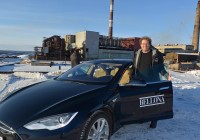
20 years on, radiation fear from wreck of nuclear sub remains
ADVERTISEMENT
Today, August 30, marks 20 years since the Soviet-era Cold War submarine K-159 sank in bad weather while being towed from the abandoned naval base of Gremikha on the eastern shores of the Kola Peninsula towards the Nerpa shipyard north of Murmansk.
Nine of the crew members lost their lives, of which seven were never found.
Russia was soon to annonce that the sub should be lifted. For environmental concerns. This was just one year after the 2002 successful lifting of the much larger ‘Kursk’ submarine that sank in the Barents Sea in August 2000. The salvage of the ill-fated Oscar-II submarine was carried out in good international cooperation spirit between the Russian Navy and European partners.
Raising of the K-159 was considered possible, although challenging due to the outer hull’s rusty conditions. But nothing happened and Europe-Russia ties turned gradually colder.
Researchers have since then monitored the wreck, fearing leakages of radioactivity from the two old nuclear reactors onboard could contaminate the important fishing grounds in the Barents Sea. A joint Norwegian-Russian expedition examined the site in 2014 and concluded that no leakage has so far occurred from the reactors to the surrounding marine environment.
Cooperation on nuclear safety in the Arctic is one of many international arenas Russia has left with its all-out war on Ukraine. Neighboring Norway, which has an extensive radiation monitoring network for air and waters close to the Kola Peninsula, assumes the reactor compartment in the wreaked submarine remains intact.
“It is not measured any leaks of radioactivity,” says Ingar Amundsen, Head of the Section for International Nuclear Safety and Security with the Norwegian Radiation and Nuclear Safety Authority.
ADVERTISEMENT
“Due to the war in Ukraine, project funds for Russia have been frozen,” he says.
“This means that there is no longer cooperation and information exchange about the environmental condition at K-159 as it was before under the Norwegian-Russian environmental monitoring cooperation,” Amundsen explains.
The bad shape of the hull could eventually lead to radionuclides leaking out, a previous study conducted by the European Union in cooperation with Russia’s state nuclear corporation Rosatom concluded.
“In 20-30 years’ time the metals will start corroding and there is a genuine risk of leakage,” Finland’s Ambassador for the Northern Dimension program, Jari Vilén, told the Barents Observer in 2021.
Vilén was at the time happy to announce that the European Union’s Northern Dimension Environmental Partnership (NDEP) decided to start a technical review aimed at finding a safe way to lift the K-159 and bring it to safe decommissioning onshore. The EU also hinted it was willing to co-finance such lifting operation together with Russia.
Like Norway, the EU froze all nuclear safety cooperation with Moscow after February 24 last year.
Future radiation fear
The two onboard reactors contain about 800 kilograms of spent nuclear fuel, with an estimated 5,3 PBq of radionuclides.
A modeling study by the Norwegian Institute of Marine Research said that a pulse discharge of the entire Cesium-137 inventory from the two reactors could increase concentrations in cod in the eastern part of the Barents Sea up to 100 times current levels for a two-year period after the discharge. While a Cs-137 increase of 100 times in cod sounds dramatic, the levels would still be below international guidelines.
However, such a potential increase could make it difficult to market the affected fish.
Lithuania-based nuclear expert Dmitry Gorchakov with the Bellona Environmental Transparency Center is worried.
“There is a possibility of leaks, of course. Especially since K-159 was not prepared for flooding,” Gorchakov says. He underlines that so far, to his knowledge, “no leaks have been found.”

When Russia took over the Chair of the Arctic Council in 2021, the lifting of old submarines from the seafloor was highlighted as a priority. Today, though, Moscow is silent on the plans as budgets give priority to building new nuclear-powered submarines and not to securing old military scrap on the Arctic seabed.
Dmitry Gorchakov says it one day eventually will be necessary to bring up the K-159.
“In the current conditions of isolation, it is unlikely Russia will be able to conduct such an operation alone. There is no necessary equipment, and there may not be money for this in the budget. I think in the coming years they will depict preparations for the lift, but nothing more,” he says.
Meanwhile, the old November-class submarine remains at the seabed as a slowly ticking radioactive time bomb 3 nautical miles northwest of the Kildin Island in the Barents Sea.
ADVERTISEMENT
The Barents Observer Newsletter
After confirming you're a real person, you can write your email below and we include you to the subscription list.









